Homeland, Overseas Military Threats Begin to Consolidate
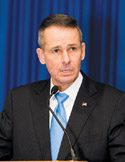 |
| Gen. Peter Pace, USMC (Ret.), former chairman of the Joint Chiefs of Staff, discusses the broad-based approach that is needed to fight terrorism at West 2008. |
The
However, success in the war on terrorism will require effective use of all government and industry resources available to the
Gen. Peter Pace, USMC (Ret.), former chairman of the Joint Chiefs of Staff, emphasized that brute force alone will not be enough to defeat the terrorists. All elements of government—the State Department and the Treasury Department, to name two—must be brought into play where their expertise can help shut down terrorist gains.
Gen. Pace’s kickoff address followed the theme of post-Iraq operations. Regarding the Iraq War, he declared that by any measure the recent surge has been militarily successful. However, although the evidence is strong—attacks on coalition forces and the Iraqi people are down—people should not focus on those facts alone. Numbers can change, and using that kind of metric cedes to the enemy the determination of whether the allies are winning or losing.
Instead, success should be measured by how the Iraqi people feel about their lives today and in the future. Achieving that success will require the kind of broad-based effort the general described earlier.
And the Iraq War is a key element in the Global War on Terrorism. Gen. Pace stated that
But the
Prevailing in this global conflict will require excellent intelligence along with ways of disseminating it to “superbly trained special operations” teams—comprising about 20 men each—who could act on that intelligence, Gen. Pace said. These teams must be on-site or close enough to trouble spots to reach areas of operations within 72 hours. Again, allies will be important in this type of operation, as the
One such area is
The general admitted that he is very concerned about cybersecurity in this information age. The nation is extremely vulnerable to cyberattack, he warned, in large part because of its heavy reliance on computer systems and networks. Those individuals who know enough about the threat to understand its danger cannot share that information with others, which hinders security measures. The federal government must establish standards for industry to spend money on security, he warranted.
And the threat is only going to grow worse. Right now, only nation-states have the computing capability to wage damaging cyberattacks on the
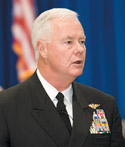 |
| Adm. Timothy J. Keating, USN, commander of the U.S. Pacific Command, reports on the state of the Asia-Pacific region and its involvement with the Global War on Terrorism. |
Adm. Keating offered that he preferred the phrase “the struggle against violent extremists” to the more common “war on terrorism,” particularly because moderate Muslims in
The People’s Republic of
Commenting on a recent court ruling limiting the Navy’s ability to train using active sonar, Adm. Keating warned that “our ability to find and fix any submarine in the Pacific is not as robust as it should be.” The Navy needs to train on active sonar, he stated, adding that if it cannot use the equipment properly, it could end up fighting with one hand tied behind its back—which probably would cost American lives. “We don’t want that, and we don’t want a fair fight. We need active sonar,” he declared.
Adm. Keating’s remarks on the importance of building international relationships were illustrated by members of one panel that examined fighting an unconventional war. Cmdr. Mike Horan, USN, former commander of a joint provincial reconstruction team in
 |
| Discussing how to fight an unconventional war are (r–l) panel moderator Vice Adm. Al Konetzni, USN (Ret.); Cmdr. Mike Horan, USN; Lt. Cmdr. Joel Lang, USN; Capt. Robert Kapcio, USN; and Capt. C.J. Kalb, USN. |
These two and other panelists highlighted the need for cultural and language education. And, above all, humanitarian forces need effective C3 just as warfighters do, they emphasized.
 |
| The topic of fighting and winning a cyberwar produced a lively discussion among (r–l) panel moderator Vice Adm. Herbert A. Browne, USN (Ret.); Brig. Gen. Jon Davis, USMC; Rear Adm. Janice Hamby, USN; David Wennergren; and Steve Cooper. |
Brig. Gen. Jon Davis, USMC, deputy commander of the Joint Functional Component Command (Network Warfare), U.S. Strategic Command, said that cyberspace is an operational domain that reaches across all other domains. Tactics, techniques and procedures need to be developed to generate a doctrine.
He pointed out that an attack on one network may affect another network half a world away. Accordingly, every cyberwarrior must possess heavy technological knowledge with good access to intelligence, particularly signals intelligence.
Training these operators will be a challenge, offered Rear Adm. Janice Hamby, USN, director of global operations (N-3), Naval Network Warfare Command. These operators must have nearly a Ph.D.-level education—three to five years’ worth—so their understanding of the networks they defend will enable them to realize when an attack may be at hand. But the presence of these trained professionals will not relieve users of their security responsibilities.
“If you’re on our nets, you had better consider yourself at least a cyberwar supporter, if not an actual cyberwarrior,” she said.
Steve Cooper, the former chief information officer for the U.S. Department of Homeland Security and for the American Red Cross, raised the specter of cyberattacks through homeland nongovernmental organizations (NGOs). Drawing from his experience with the Red Cross, Cooper suggested that terrorists could wreak havoc with the nation’s health care by accessing the nation’s blood supply databases and changing vital information. The country has been fortunate that cyberterrorists have not thought about attacking through NGOs—so far.
Everyone—soldiers, sailors, airmen, Marines and civilians—is a combatant in the Global War on Terrorism, many speakers and panelists said. While military personnel take the fight to the enemy overseas, civilians on the home front have their own duties to deny success to extremist evildoers. One panelist even offered that the
But while public attention has been focused on
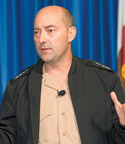 |
| Adm. James G. Stavridis, USN, commander of the U.S. Southern Command, warns the audience that drug smuggling poses a significant threat to U.S. national security. |
Drug trafficking is entering the world of terrorism. Some terrorist movements in
And the drug traffickers are becoming more sophisticated and innovative. They have been employing semi-submersible watercraft that can carry up to 5 tons of cocaine. These vessels and their two-man crews can sprint at speeds of up to 15 knots. Several have been caught in the past year, the admiral noted, and the traffickers continue to improve upon them.
Drugs are not the only potential cargo for these craft. Any seagoing vessel—whether a semi-submersible or a freighter—that can smuggle a sizable shipment of drugs also could be used by terrorists to sneak a weapon of mass destruction into the
 |
| Considering the war on drugs from a variety of perspectives are (r–l) panel moderator Adm. James Loy, USCG (Ret.); Maj. Gen. Herbert A. Altshuler, USA; Rear Adm. Joseph Nimmich, USCG; Special Agent Michael A. Braun, DEA; and Bob Knotts. |
Special Agent Braun explained that state sponsorship of terrorism has declined, and the
Adm. Stavridis noted that to help in its drug interdiction efforts, SOUTHCOM will need full-spectrum awareness, particularly maritime domain awareness; distributed, networked wireless sensors; long-dwell unmanned sensors; and an improved version of relocatable over-the-horizon radar. It also may be able to use an effective version of airborne laser mine detection technology to pick up semi-submersibles, as well as surface-towed torpedo technology to find fast boats used by smugglers.
And, SOUTHCOM is “very into rivers,” Adm. Stavridis offered. The m-hull Stiletto, built by the Office of Force Transformation (SIGNAL Magazine, March 2006), will be employed to help conduct counternarcotic operations.
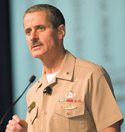 |
| Rear Adm. Michael P. Tillotson, USN, commander, Navy Expeditionary Combat Command, describes the new emphasis on riverine and other related naval operations. |
Roughly 90 percent of the world’s commerce travels through sea lanes, he observed. Many of these are coastal waterways; and to cover them all, the Navy must engage and partner with others, the admiral stated.
Many enemy naval forces look like the Coast Guard or are even smaller, he noted. The NECC has a significant presence in the Central Command’s area of responsibility, and it has “a lot going on in Africa,” including two vessels in the Africa Partnership Station in the
Gen. James T. Conway, USMC, Marine Corps commandant, characterized the war on terrorism as far-reaching and long-term.
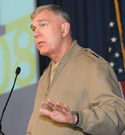 |
| Gen. James T. Conway, USMC, Marine Corps commandant, outlines the status of the Marine Corps in the war on terrorism. |
The fight in
And, the Corps’ expeditionary nature is in need of a boost. Gen. Conway warned that the Corps has an entire generation of Marines who are combat-hardened but never have set foot on a ship. The Corps is losing expertise and is becoming “out of whack” with its expeditionary nature, he charged. Many Marines are not doing mountain, jungle, cold weather or combined arms training. They have become land warriors, and they need to get back to being a lighter, faster Marine Corps, he said.
Another problem facing the Marine Corps is the strain placed on it by ongoing combat operations. The Corps has had to borrow materiel from maritime prepositioning ships, one of which is down to 60 percent of its capacity. Equipment in
The relationship between the Marine Corps and industry is pretty good, the general allowed. Two things sit atop the Marine Corps’ wish list: a way to defeat improvised explosive devices and a new helmet that can stop a 7.62-millimeter round that is the favorite of enemy snipers. Gen. Conway also called for the development of asymmetric ways of countering the enemy’s own asymmetric warfare tactics.
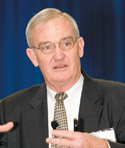 |
| Lt. Gen. John M. McDuffie, USA (Ret.), vice president, U.S. Public Sector, Microsoft Corporation, describes the private sector’s involvement in the war on terrorism. |
Gen. McDuffie stated that technology exists to drive collaboration, but the Defense Department “must get serious about [collaboration].” Existing technologies can run mobile systems on the secret Internet protocol router network (SIPRNET)—“It should already have been here,” he charged.
For future technologies, visualization tools will evolve and change everyone’s lives, Gen. McDuffie predicted. Coupling geospatial technologies with simulation will lead to incredible capabilities. Parallel computing holds great promise for solving the problem of excessive heat generation from increasingly dense processors.
However, the
As important as technology is to
Photography by Michael Carpenter. Additional photograpy.




Comments